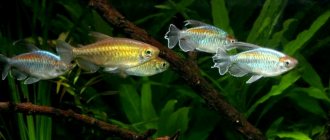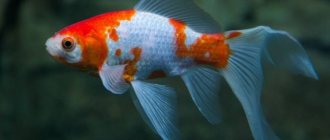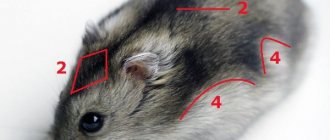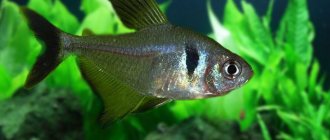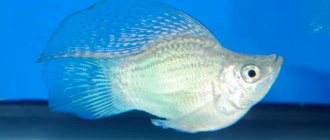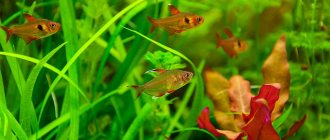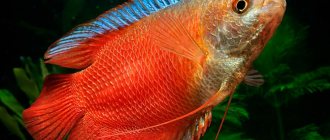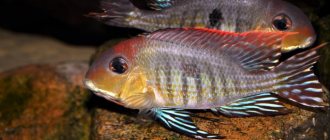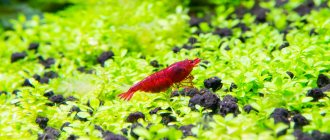- Wild animals
- >>
- Fish
The veiltail is a real goldfish with long fins and a beautiful veil tail. Japan is considered the birthplace of these fish. Veiltails are considered the most common aquarium fish today; thanks to their beauty and unpretentiousness, these fish are loved by aquarists around the world. They are not found in the wild; they live only in artificial reservoirs and aquariums.
Description
Veiltail is a species bred artificially in the east. It can be classic or ribbon. In the classic one, the length of the tail parts is the same, but in the ribbon ones, the fused tail blades have different lengths. The value of an individual depends on the number of “fans”; there are a maximum of 4 of them.
Appearance
The fish grows up to 20 cm and has a short, round body. The veil tail is forked. All fins are elongated and pointed. The dorsal fin is more than half the height of the body. The eyes are large. Colors come in black, white, gold, red and orange. Popular color forms: red body and white fins, golden red, and spotted.
Behavior
Goldfish are harmless and slow-moving inhabitants of aquariums. Suitable for single and group keeping. They dig in the ground and dig up plants with a weak root system.
Lifespan
In good conditions, the fish lives 10–15 years.
Water parameters
Veiltails love cool water; the optimal temperature for them is from 14 to 23 degrees. You should not add heat-loving fish or increase the water temperature - this will lead to diseases in your pets. In addition to water temperature, it is important to meet the following criteria:
- acidity – 7;
- hardness – 6-18.
Aquarium
Based on the size of the fish, and they can reach 20 cm, the aquarium should be spacious, at the rate of 50-80 liters of water per fish. The smaller the aquarium, the less comfort the pet experiences, it stops growing and may get sick. The water in the aquarium for the golden veiltail must be changed by a third every week so that harmful substances and decay products do not accumulate in it.
Priming
The soil for fish should first of all be safe. It is better to place round-shaped pebbles in the aquarium, since the fish likes to dig at the bottom and can injure its mouthparts with sharp stones. The size of the stones should be such that they do not fall into the fish’s mouth. Also take into account. That sharp edges can harm the fins, so you should not buy soil and grottoes in order to add beauty - this can harm the inhabitants.
Equipment
If we talk about additional equipment, then first of all you will need a powerful filter. Fish love to pick up dirt from the bottom, so the water must be well filtered so as not to cause illness in pets. To supply oxygen, install a compressor that corresponds to the displacement of the aquarium; be sure to read the description of the equipment and do not set a lower power.
Lighting
In maintenance and care, veiltails prefer natural light, the length of daylight hours according to the season. If you cannot place the aquarium in a place where there is light, then you need to provide electric lighting with medium-power lamps.
Plants
Veil-tailed fish, like many other inhabitants of the aquarium, love to eat plants. It is best to plant elodea, anubias or cryptocoryne for this purpose - such algae grow quite quickly and will not let your pets get hungry. It is advisable to strengthen the roots as much as possible or take plants with a developed root system - curious veil tails like to dig the soil with their nose and simply pull out the greenery in the aquarium.
Application
Thanks to the unique set of substances that white cinquefoil contains, the use of this plant is very diverse:
- prevention of iodine deficiency;
- improving the functioning of the endocrine system;
- restoration of hormonal balance;
- beneficial effects on the functioning of the stomach and intestines;
- providing anti-inflammatory, antiseptic effects;
- fight against tumors;
- stabilization of the heart and blood vessels;
- stimulation of the central nervous system;
- removal of radionuclides and preventing accumulation in the body;
- slowing down cell aging, increasing immunity;
- normalization of mental state, fight against depression;
- providing a slight analgesic effect;
- increased performance, improved mood.
One of the common traditional methods of treatment is tincture of white cinquefoil. To make it, both the leafy and root parts of the plant are taken, depending on what needs to be cured. For example, the roots of a plant are more saturated with biologically active substances compared to the above-ground part. Several recipes are known.
- Tincture from the leafy part
For brewing, it is better to take a thermos, but other suitable containers will also work. Pour 200 ml of boiling water over two tablespoons of dried herbs, let it brew for 9 hours (it’s better to do it in the evening), strain through cheesecloth or a fine sieve. To reduce blood pressure and normalize the functioning of the central nervous system, a tincture of white cinquefoil prepared in this way is used; the instructions for use are very simple. You should drink a third of a glass before meals. - Alcohol tincture
Crush 50 g. dried pentapala roots using a hammer, food processor or other convenient method. Pour the resulting powder into a clean glass jar and add half a liter of vodka. Hide the closed jar in a dark place for one month. Stir the liquid occasionally and strain before use. You need to take thirty drops of the remedy before meals. - Mixed tincture
To prepare, you need to mix the dried stems, leaves and crushed root parts, pour boiling water (250 ml) over the mixture. Let it brew for 9 hours, strain well before using. Take 1 to 3 spoons before meals. Drink the tincture during thyroid problems.
Another way to overcome this disease using the root of the white cinquefoil is the use of endonorm - a medicine in the form of capsules. The active ingredient is white cinquefoil, endonorm is available without a prescription. Even taking into account the fact that it is based on plant extracts, there is no need to self-medicate. Before use, it is better to consult a qualified specialist.
An indispensable substance is a decoction of cinquefoil root (boil 20 g of root for 15 minutes in 250 ml of water). It heals wounds well, promotes tissue regeneration, and acts as an antiseptic. To get rid of eczema, numerous bruises, boils, purulent wounds and other diseases of the skin, lotions from the prepared decoction help. And rinsing the mouth will help get rid of stomatitis and bleeding gums.
The infusion of this herb treats uterine bleeding due to hormonal imbalance. For this purpose, one tablespoon of root powder is poured into a liter of boiling water and the mixture is placed in a water bath. After 15 minutes, remove, allow to cool and strain. The decoction should be consumed before meals, half a glass. This remedy will help normalize hormonal balance and strengthen the body.
Kinds
There are several varieties that differ in color and tail shape. There is also an albino form of goldfish.
Calico
The color consists of orange, white and dark spots. The calico veiltail has problems with coordination due to its large fins.
fantail
The tail resembles a fan and is equal in length to half the body. The breed is characterized by a fin angle of 90 degrees between the upper and lower blades.
Black and red
Rare and valuable species. Fins come in different shapes.
What to feed
The diet of veiltails should consist of 70% plant and 30% animal feed. For these purposes, the aquarist can use dry food - flakes, granules, chips intended for goldfish, frozen or live food - brine shrimp, bloodworms, daphnia. Fish eat duckweed, riccia, lettuce, and spinach well. Do not overfeed your pets under any circumstances. Feed them little by little twice a day.
Compatibility
Stock veiltails with peaceful species adapted to cool water:
- some irises;
- zebrafish;
- swordtails;
- cardinals;
- speckled catfish;
- ancistrus.
The ideal option is to live in a group of 4-6 individuals. Veiltails get along well with similar varieties of goldfish: shubunkins, ryukins or telescopes. Remember that veiltails interbreed with other species of goldfish. Veiltails cannot be housed with tropical fish and fin-biting species:
- barbs;
- tetras;
- cichilds;
- cockerels;
- boots;
- macropods.
Veiltail - breeding in an aquarium
Before spawning veiltail goldfish, the aquarium must be properly prepared. Firstly, there should be a lot of space and free space, secondly, constantly fresh water in the aquarium is necessary, and thirdly, the number of plants should be reduced, giving preference to small-leaved ones. It is advisable to place the spawning tank under the rays of the sun for several hours, but it is better to leave it there until the fry appear.
As soon as spring comes, sexually mature individuals organize mating games: the males stay closer to the egg-laying shed and the female. At this time, it is better to place them in different aquariums, otherwise some males may begin to feed on eggs. During this spawning period, the food must be live.
Veiltail Spawning
Spawning begins by placing two or three males together with one female. In this case, you need to slightly increase the temperature of the water in the aquarium. However, it is undesirable to plant the first males you come across, even if they are individuals with a short caudal fin, otherwise it will be difficult for them to pursue the female. And the offspring will also have short fins. You can determine whether a male is ready for spawning by the color of his gill covers and pectoral fins. You can notice a rash (white grains) on them. The female is ready to spawn when her abdomen is noticeably full. She tries to stay closer to the bottom of the aquarium as she begins to spawn. The males pursuing her immediately fertilize these eggs.
The eggs stick to the leaves of plants because they have a sticky consistency. The diameter of the egg is one and a half millimeters. The next day, the eggs lose their amber color and become difficult to notice. After spawning is completed, it is necessary to reduce the water level in the aquarium by about 15 cm. During this period, you need to carefully monitor the water temperature, since the slightest fluctuations can destroy the eggs.
Eggs that have not been fertilized must be removed, otherwise they will become overgrown with fungus and clog the aquarium. After 5 days, after a 4-day incubation period, the fry appear. They need plenty of daylight, especially sunlight, but the aquarium should not be left in direct sunlight for long periods of time (maximum 2 hours per day). At first, the fry feed on ciliates or rotifers; this food is enough for them. Then you need to purchase special food designed specifically for fry of this type of fish.
General Content Features
The aquarium must have a volume of at least 50 liters for a couple of individuals. Small round aquariums are absolutely not suitable as they cause vision problems and stunted fish growth.
Water indicators: temperature 12-18, hardness no more than 20, acidity 6.5-8.
Active filtration and aeration of water.
The soil is made up of coarse sand and small stones without sharp edges, as many veiltails like to dig at the bottom in search of food.
Particular attention should be paid to the decorations. They should be smooth, without sharp edges, and there should be a large space for swimming, otherwise the beautiful long fins of the fish will soon tear and resemble rags
The same approach should be taken with vegetation; dense thickets should be avoided and preference should be given to soft, small-leaved greenery.
Pay special attention to the feeding regimen. The fact is that these fish are most often sedentary and lazy
Too much food will lead to obesity and disease.
Therefore, the amount of food per day should be no more than 3 percent of body weight. It should be divided into 2 parts and given in the morning and evening. Remove the remains. A fasting day is recommended every week. Feeds can be given combined, vegetable, live and dry.
Cockerel fish.
Natural enemies of veiltails
Photo: Female Veiltail
Paradoxically, the main enemy of goldfish can be their own food.
These harmful foods include:
- cyclops;
- dragonfly larvae;
- hydra.
This uneaten food can be eaten by the fry. For example, in just a week, a dragonfly larva can destroy an entire brood of fry. Adult fish are harmed by leeches and swimming beetles. More nimble and predatory fish such as barbs and angelfish can tear off fins and tails of adult fish. Almost all fish that live in an aquarium eat fry, so you need to have separate aquariums for fry of different ages. The next factor why fish can get sick and die is unfavorable conditions.
If fish swim on the surface of the water and gasp for air, it means that the water is not sufficiently saturated with oxygen. If the fish become lethargic, the water temperature may have dropped and needs to be raised. Fish cannot tolerate tap water, it contains chlorine, so when using tap water, it needs to sit for several days before pouring it into the aquarium, but it is better to use purified water. There should be at least 50 liters of water per fish, so make sure that the aquarium is not overcrowded, otherwise the fish will stop growing and will not feel well. In ponds and open water bodies, danger threatens fish at every turn.
The main enemies that can attack veiltails in a pond are:
- tadpoles;
- frogs;
- newts;
- snakes;
- swimming beetles;
- snakes;
- water rats;
- cats and dogs.
Goldfish are very visible in the water, so waterfowl such as gulls and jackdaws love to hunt them. Magpies, crows and other birds. Therefore, the pond where goldfish live needs to be protected as much as possible. Often aquarists are afraid that goldfish will get sick, but veiltails don’t have many diseases.
Mostly goldfish are affected by diseases such as:
- scabies;
- dermatomycosis;
- clouding of scales
- intestinal infections.
Cloudiness of the scales is caused by ciliated ciliates. The areas of the body affected by the disease become rough, and the disease causes complications. Scabies. Scabies occurs from bacteria that multiply among uneaten food. Whitish mucus appears on the fish, and the fish begins to itch on the stones. This disease requires a complete water change and washing of the algae and soil.
Dermatomycosis is a disease caused by a fungus; it is a secondary infection and appears on weakened individuals. It is manifested by the appearance on the fins or gills of thin threads growing from the body of the fish. Hyphae grow along the skin and gills and enter the internal organs through the muscles. The fish falls to the bottom. Treat fish in cool (about 18 degrees), salted water, changing it daily. The water is not taken from the aquarium, but clean. The fish are also given baths with the addition of potassium permanganate.
Provide proper care
When caring for fish, it is important to protect them from damage to their luxurious tail fins. The aquarium should not contain driftwood with needle-like knots or stones with sharp edges.
The veiltail is characterized by a peaceful, calm character, so you should avoid proximity to aggressive fish that can pluck its luxurious fins. With quality care, the veiltail fish can live up to 20 years.
Adviсe
- Goldfish are voracious and beg for food even if they have eaten too much. Do not violate the feeding regime, because it is better to underfeed the fish than to overfeed it.
- To boost immunity, add salt to your water. Be careful when calculating the required salt concentration. Smoothly transfer your pets to salted water.
- Quarantine new fish for a month. This will prevent diseases from being introduced into the aquarium.
- Periodically check the condition of the water with special tests. It is especially important to do this in the spring, when the composition of the water is unstable.
- To measure the water temperature, use a thermometer immersed in water. Such a device will provide accurate data.
Veiltails are beautiful and unusual inhabitants of the aquarium. Goldfish are also interesting because they can survive in water temperatures below 10 degrees.
Sources
- https://aquarium-fish-home.ru/zolotye-rybki/vualexvost-ili-veeroxvost-soderzhanie-razvedenie-sovmestimost/.html
- https://RibnyDom.ru/fish/rybka-vyalehvost-soderjanie-i-yhod-kak-vygliadit-vidy-sitcevyi-skolko-jivyt-foto-razmnojenie-sovmestimost.html
- https://akvariumfish.ru/akvariumnye-rybki/zolotaya-akvariumnaya-rybka-vualehvost
- https://aqua-south.ru/vualehvost-soderzhanie-razvedenie-sovmestimost-s-drugimi-rybkami/
- https://wildfauna.ru/vualexvost
- https://rybkies.ru/rybki/vualekhvost.html
[collapse]
